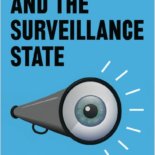Covering Surveillance
The Visualization of Contemporary Surveillance on Scholarly Book Covers
Fig. 1: The cover of Aziz Choudry’s (ed.) Activists and the Surveillance State combines imagery of vision and sound. 1_Introduction In their editorial to this issue of On_Culture, guest editors Wolfgang Hallet and Wibke Schniedermann foreground an essential question concerning the historical specificity of contemporary surveillance cultures: “How do films and other media visualize the invisible processes of surveillance?” [1] Our _Perspective deals with this question in a self-reflexive fashion in that we suggest examining the book covers of scholarly publications from the field of surveillance studies. We are interested in how these book covers illustrate the dilemma of visualizing the increasingly less visible phenomenon of surveillance. Our ideas are grounded in the emerging interdisciplinary field of invisibility studies, which is especially interested in the shifting contemporary configurations of what is regarded as visible and what is not. [2] Within surveillance studies, it follows up in particular on Jonathan Finn’s 2012 study of the representation of surveillance in stock imagery. If surveillance is “the dominant organizing practice of late modernity,” [3] surveillance is also “a fundamentally narrative act,” as Betiel Wasihun has argued. [4] Its deep structure is defined not only by the transformation of one state of affairs to another but by metaphors of vision, visibility, and invisibility. At first glance, this does not seem to apply to the current importance of “dataveillance,” [5] the forms of which increasingly subsume more traditional modes of audiovisual surveillance. Yet attempts to grasp the specificity of contemporary regimes of surveillance such as the “global eye” cannot escape the visual dimension. [6] This thesis is strikingly illustrated by Jeff Coons’s video contribution to this issue of On_Culture, “GlobalEyes,” which assembles publicly available CCTV camera footage. [7] It is further supported by the contribution by Martin Hennig and Miriam Piegsa, who argue that contemporary media representations of dataveillance in films, documentaries, and video games employ certain recurring visual metaphors based on the “[p]ersonalization and spatialization” of dataveillance. [8] The general cultural relevance of concepts of visibility and invisibility has been highlighted in this issue of On_Culture by Wasihun, who links these abstract ideas to the social dimension of shame. Emphasizing that contemporary dataveillance makes “the question of how to define interiority […] even more urgent,” she convincingly argues that the “concepts of visibility and invisibility […] are not outdated in the context of dataveillance.” [9] The advent of post-panoptic surveillance thus certainly marks a…
